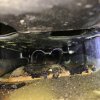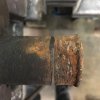This job went better than I had hoped.
I bought two length of 1.4m long stainless steel tubing, 35mm OD, 1mm wall thickness (1,5mm works also).
The 1.4m is a little long, more on that later.
Cut the old tubes front and rear with an angle grinder with a fresh cutting wheel (so that you have the full OD of the cutting wheel to work with). Leave about an inch sticking out of the tunnel front and rear.
On my car, although the very ends of the old tubes looked bad with rust holes in them, the rest of the tubes were actually quite sound so I was able to reuse the cut off bent sections. This seems to be the case on most cars.
The rear bent sections will fall right off, the fronts are held on by two brackets.
With a buch of wiggling and twisting, I was able to pull the pipes through the brackts without cutting them. To do this I had to unbolt the brackts holding the track rods to the floor of the car:

Then, hit the pipes with a hammer from the rear of the car and they should move out towards the front fairly easily without mushrooming the end of the pipes.
Pull them out the front while twisting with a pair of channel lock pliers.
Peek inside the tunnel and you can see the brackets holding the pipes (in the background of the pic. Yellow stuff is old cavity wax, "wall" in foreground seems to be insulation material, heater pipe is on the left):

Dent the floor up a little where the short pieces of connecting hose and their hose clamps will sit to give these some space.
Slide in the new pipes from the front. They slid in super easy on my car:

I cleaned the crud out of the bent sections with a pot scrubber on a string:

On one tube, I cut off the badly corroded end:

I cut the not-so-old rear hoses into sections to connect the pipes:

This is what it looks like in the rear, the pipes are too long and I will have to shorten them:

This is an easy job if the bent sections can be reused.
If not, you could probably go to a muffler shop and have them bent from new pipe (we don't have muffler shops over here unfortunately).
In summary, I would never remove the bottom tunnel except maybe to repair some bad rust.
Even if you wanted to use the nice stainless reproduction pipes, you could cut them and slide them through and reconnect, maybe even by welding.
After installing these pipes, the method of sliding smaller OD tubing through the old tubing makes no sense to me anymore.
This is much easier and yields a better result.







